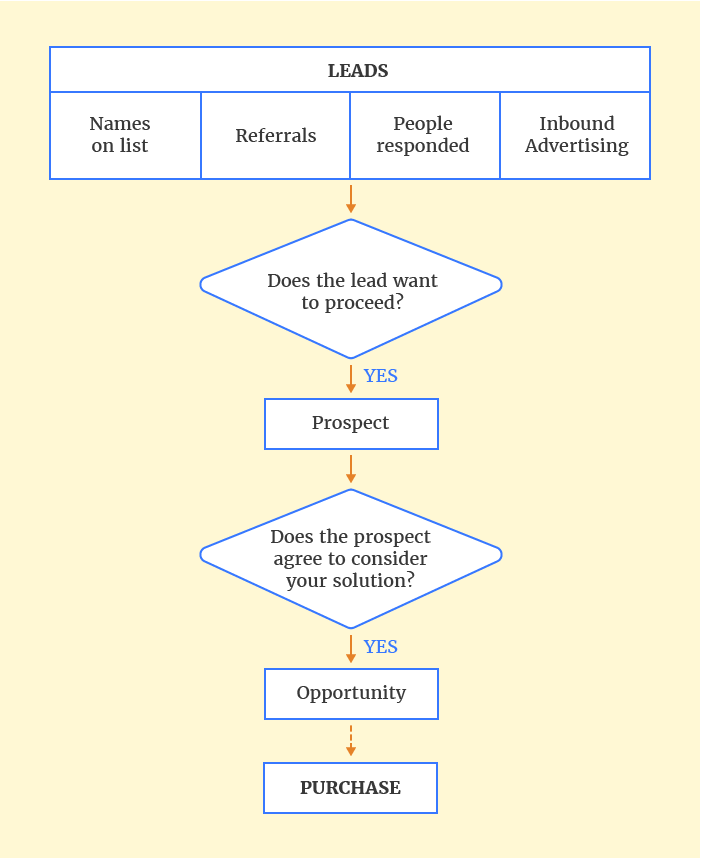What is a Suspect In Sales?
A suspect in sales is a person that seems to have all the characteristics of a potential customer but will never convert that into real interest in what you are selling. They will stick around for a certain amount of time in the sales conversation and funnel process without any means or intention to buy the products you’re selling.
Identifying these suspect “leads” quickly means less frustration, less wasted time, and (typically) higher conversions.

You may be thinking, “I know they are the people I don’t want to talk to, but how do I identify them?” Well, it’s tricky.
Oftentimes, these pipeline fillers are just as active and engaged as any other lead. It makes them very difficult to identify in the marketing phase. They have different reasons for giving you signals that they may buy what you are selling:
- Some are just bored at work, looking for stuff they can claim is relevant,
- Others may have been assigned to research a solution by their boss but don’t have pocketbooks to make the buying decision,
- Others may just have wanted your downloadable resources or thought the webinar sounded good and decided to stick around to see what other freebie you may send their way.
Sure, suspects may buy in the future. However, now they’ve got nothing for you and you have a decision to make on whether you string them along or set them aside. That’s the importance of knowing how to identify a suspect.
How do you identify these particular leads and stop wasting time? Good question. To answer, we first have to look at the definition of a “prospect”.
What is a Prospect in Sales?
A prospect in sales is a lead that is worth your time. They are a lead who is genuinely looking for a solution to their problem and has probably expressed their needs to you. They are willing to hear about your offer in order to make an actual buying decision.
If you were doing demos for prospects all month long, you can genuinely count these as possible sales. Your quota woes could be a thing of the past. Individuals who qualify as prospects may include:
- A decision-maker that is researching a new solution for a common pain your products solve,
- A member of a buying team charged with finding a solution/better solution similar to the one you offer,
- A supervisor of the decision-maker who has involved him or herself in finding a solution.
Keep in mind that prospects still need to be closed.
The point of this post isn’t to give you a magic bullet that means just dialing the digits and sending the invoice with a modern design. Our intention is to help you define, determine, and identify the differences between those who are close to buying and those that aren’t, i.e suspects vs prospects.
Prospect vs Suspect – What’s the Difference Between Them?
Do you ever wonder what the world would be like if everyone said exactly what they thought, no matter what? If you have, it’s probably led to the imagination of a bleak existence that has left you thankful for reservation and politeness.
Honesty is often comes across as harsh, especially when dealing with the general public. Although, it would be nice if people didn’t waste your time. As a sales rep, it never gets any easier to give your best effort during a demo or sales call just to realize (sooner or later) that the person you’re talking to is not serious.
With suspects, you will eventually realize that they aren’t going to buy. That they knew it all along. It’s not a nice feeling to find this out because it means you have wasted your most valuable resource as a sales rep, which is your time.
While you may hold onto your frustration for a while after these calls, you can at least be comforted by knowing you may not have to deal with as many going forward.
Knowing the difference between suspects and prospects and how to label leads in your funnel quickly will save you precious time.
Here’s what differentiates prospects from suspects:

Suspects typically don’t give any proprietary information away
In any conversation, it’s a two-way street. One person talks, the other listens—and vice versa. Click To Tweet Both suspects and prospects will talk with you, engage with your content, and maybe even reply to your emails and answer your calls.
However, if you listen closely and ask the right questions (more on that further down); you should be able to tell a suspect and a prospect from the responses to your questions.
A suspect will not give up the information you need to determine their readiness to buy. After the call, you will still not be able to tell if their problem affects them in significant ways and how soon they may want to solve it. They will remain on the fence for as long as they can.
So, the counterintuitive answer for how to tell a suspect from a bonafide prospect is: If you can’t get the information you need from a lead, they are most likely a suspect.
Why?
The suspect lead isn’t really looking for a solution and that means they don’t have to give you proprietary or other knowledge that isn’t public.
If someone is genuinely looking for a solution, they’ll give you the details of their problem and how it has affected their life, work, or business (if you ask them to tell you). So, the simple trick is to ask qualifying questions. But it’s not quite that simple.
If you are on a sales call, you get the ball rolling to the point of momentum. It’s only a good thing if they buy. If they don’t, you’ve wasted an hour or so of your life. That’s the sad effect of not qualifying suspects early in the discovery call.
Even if you find great qualifying questions to weed out the suspects, you’re on a “sales” call. At the moment you realize this, do you end the call with, “Hey! You’re just a phony!!”
Of course not. We don’t live in a world where you can just say what you think, remember?
4 Benefits of Qualifying Sales Suspects Early
You can weed out suspects in marketing by making a quick qualifying call to determine the severity of a supposed lead’s need. This is not a sales call; it’s more of a sales discovery call that determines a lead’s fit and readiness to buy.
You can use live chat for this, but it’s best to do this on an actual phone call. The benefits are so many it could warrant its own post. However, we will go over a few here:
1 Instant weed eater
Offering a call to suspects is like kryptonite to the majority of them. Mention that you’ll be asking them some quick questions to determine their needs and they’re outta here. It’s the equivalent of approaching a person in a retail location and hearing, “just looking!” That instantly weeds out the suspects.
2 Prospect identifier
Offer the same call opportunity to a prospect, and they’ll perk up. Depending on the immediate nature of their need, they may even clear their schedule to squeeze the call in.
So much of sales is reading the responses of your leads to determine if at all they could become paying customers.
3 Professional appearance
Believe it or not, it looks way better on you to add a step to the process. This is especially true in B2B sales and when selling high-priced items.
Having a qualifying call shows the lead that you have a process (a.k.a. you have your stuff together). It’s just professional to ensure the quality of the potential partnership.
4 Pre-sells prospect
If you recognize on your call that the person on the other end is a prospect, don’t just end the call. Begin casting the vision that your products will create.
Find out as much information as you can and use it to tailor your demo or sales call. They’ll be more excited for the next call and so will you.
5 Questions to Ask During a Suspect Qualification Call
When you qualify a suspect, you are fixing the suspect vs prospect conundrum in two important ways. First, you are finding out if this lead is a time waster that you have to remove from the sales pipeline.
Second, you are determining the readiness of the lead (those that aren’t suspects) to make a purchase. Only then can you decide if they are ready to take a sales call or to continue nurturing them.
If you are talking to a suspect, you want the call to end in under 10 minutes. Longer than that and you’ve just wasted time you could be qualifying actual prospects.
When speaking with a genuine prospect the call may run up to 45 minutes. But, provided you ask the right questions, this is 45 minutes well spent.
Remember, if you’re picking up clues the lead may be a prospect; it’s time to start preparing your pitch. Click To Tweet Keep them on the line and gather all the intel you can to rock your demo, but DON’T pitch them.
Once they’re more interested and looking to talk further about the solution—END THE CALL. Seriously, we didn’t mean to yell at you in all caps, but you’ve got to stop short of your pitch. Consider this a bonus tip. It’s about the process.
Sure, sometimes they’ll be ready to buy right then and there. Rare, but it happens. Scheduling a call allows you to use the intel in your pitch later and gives you a point to refer back to (namely the qualifying call).
Here are a couple of template questions that you can ask a lead to determine if they are a suspect or lead. Take these and tweak them to fit your needs.
1 What has caused you to find a solution for [pain/problem]?
When a lead is willing to openly discuss their problem and how it’s affecting them, you take it to mean they are more likely to buy.
Suspects seldom divulge details of their problems. Either they were just doing the research for their boss or the person who has the decision-making power, their situation is not severe enough, or they are in the earliest stages of their buyer’s journey and aren’t anywhere close to choosing a solution.
2 Have you used any other solutions (either third-party or in-house)?
That a lead has a solution in place – albeit one that is not adequate – means the problem affects them severely enough to invest in a solution. This behavior is not consistent with suspects that usually don’t have a solution in place or aren’t affected by the problem severely enough to be looking for an upgrade on their current solution.
A positive answer to this question also gives you important intel on how well their current solution compares to what you will be offering them. Knowing the strengths and weaknesses of the prospect’s current solution also allows you to emphasize areas your product does better than their current solution when you make your pitch.
3 Do you have a budget in mind and how does the purchasing process look at [business]?
This type of information is not easy to coax out of the lead so early in the sales process. Essentially, this question helps you discover if the person you are talking to has decision-making power. If they don’t have the power to make the final decision, they are likely a suspect. You would need to get in front of the actual decision-maker.
If the person you are prospecting has no decision-making power, you can get the information you need to structure a deal. Neither can you get a sense of when the purchase may happen because the person doesn’t really know?
4 What issues or concerns could keep you from making a decision to solve [pain/problem] in the near future?
If they are going to be objections to the sale, it is best you know now. You may discover the objections the lead has to be too great to be overcome. Perhaps, they can’t afford your solution at this point. That would make them a suspect. Maybe one that shouldn’t be tossed completely, but a suspect all the same.
5 If you don’t purchase a solution, who and how would that affect your workplace?
If a problem troubles the lead so much to keep them up at night, they could be labeled a prospect. If their business is so affected that it is starting to hurt their sales – customers are complaining and threatening to take their business elsewhere, you could be sure they are looking for a solution and could force the purchase into the budget no matter how tight finances are.
While these are (very) general questions, tailoring them to your qualifying call will yield valuable data from prospects and send suspects on their way without the wasted time of a full pitch.
A Sales Pipeline With a Few Prospects is More Valuable Than One Stuffed Full With Suspects
Failing to separate suspects from prospects gives you inaccurate sales projections, which is a common point of frustration for sales teams. It also wastes time, a valuable resource that can’t be recovered.
Determining who among your leads is a suspect and who is a genuine potential customer requires asking the right questions during the discovery call.
You want to the answers to your questions to give you a sense of the extent of the problem and how much it affects the prospect, whether they have some solution in place, how soon they can buy, and if they have decision-making powers.
If the answers to these questions are vague and don’t give much away, you are likely dealing with a suspect. A prospect will not only be happy to take this call but will give you private information that shows that they trust you and are indeed looking for a solution.
Now that you know the difference between prospect vs suspect and have hopefully gathered some information about the problem and the current solution, if any, it’s time to get to work. Get your list of qualified leads, start weeding out suspects and warm up prospects.
Want to help contribute to future articles? Have data-backed and tactical advice to share? I’d love to hear from you!
We have over 60,000 monthly readers that would love to see it! Contact us and let's discuss your ideas!


